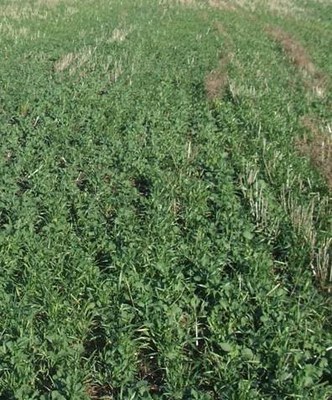Grazing Cover Crop
|
An early harvest combined with fall rains produced opportunities for post-harvest cover cropping this year. Cover crop mixtures seeded in early August emerged well with late August rain and have been making good growth in the above average favorable September weather. Fall seeded mixtures dominated by cool season species as oats, barley, turnips, radishes, peas etc., will continue growing through most of October tolerating frosts down to the mid to upper twenties. Similarly volunteer canola, pulse, and grain crops will provide fall grazing potential. As cattlemen make plans to utilize the cover crop forage for fall grazing in the next couple of months there are a couple of things to keep in mind. Turning on early when plants are small and tender will diminish potential grazing days. If turn in can be delayed and we are still experiencing favorable growing weather till the cover can reach a height of ten inches, we might double carrying capacity. Nutritional quality is primarily determined by plant stage and species. We can expected feed value to be very high and support animal gains. High moisture content plants as turnips can be expected to be laxative and lacking fiber. Old hay, straw, or access to mature pasture or corn stalks while grazing helps balance the ration and improves performance. Over consumption of young very digestible plants could also result in bloat. This risk can be managed by turning in full cattle and providing some drier more fibrous feed at turn in. For the most part, soil nitrogen availability will be quite low and the risk of nitrate poisoning from plants stressed by frost and not converting nitrogen taken up to safe forms may exist. Again don’t allow hungry cattle to over consume and consider sending in a sample for a nitrate test if the field site may be high in nitrogen. If a grain is included in a mix and it has ample season to produce seed and mature prior to grazing an additional risk is created. Unadapted cattle overloading on oat grain as an example from nipping off the seed heads could easily experience a digestive problem as acidosis and bloat. These fields may need to be strip grazed to manage intake or a starch based grain fed for a week or two prior to turn in to adapt the rumen to grain. |


